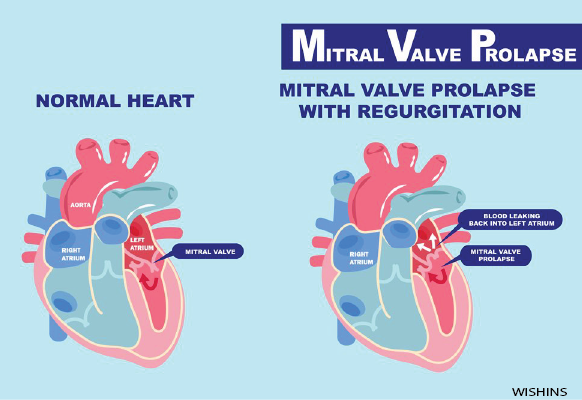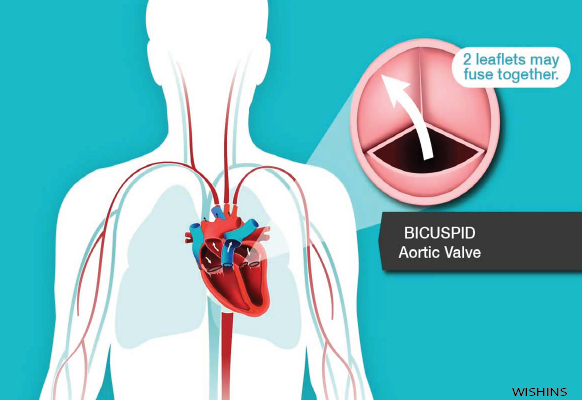Understanding Mitral Valve Prolapse Causes, Symptoms, and Treatment
Mitral valve prolapse (MVP) is a heart condition that affects the mitral valve, one of the four valves in the heart. It is a relatively common condition, with an estimated prevalence of 2% to 3% in the general population. Understanding the causes, symptoms, and treatment options for mitral valve prolapse is essential for individuals diagnosed with this condition, as well as for their healthcare providers.
The mitral valve is responsible for regulating the blood flow between the left atrium and the left ventricle of the heart. In a healthy heart, the mitral valve opens and closes smoothly, ensuring that blood flows in the correct direction. However, in individuals with mitral valve prolapse, the valve’s flaps, known as leaflets, do not close properly. Instead, they bulge backward into the left atrium during the contraction of the heart, which is also known as systole.

Causes of Mitral Valve Prolapse: Unraveling the Underlying Factors
Mitral valve prolapse (MVP) is a complex condition with multifactorial causes. While the exact underlying mechanisms are not yet fully understood, research has shed light on several factors that may contribute to the development of MVP. One significant factor is believed to be genetic predisposition. Studies have shown that MVP tends to run in families, suggesting a hereditary component. Mutations in certain genes involved in the structure and function of the mitral valve have been identified in some individuals with MVP.
Connective tissue disorders have also been associated with an increased risk of developing MVP. Conditions such as Marfan syndrome, Ehlers-Danlos syndrome, and other collagen-related disorders can affect the integrity and elasticity of the connective tissues, including those within the mitral valve. These structural abnormalities can lead to the prolapse of the valve leaflets.
In addition to genetic and connective tissue factors, there is evidence to suggest that hormonal imbalances may play a role in the development of MVP. Changes in hormone levels, particularly estrogen, have been linked to alterations in the connective tissue properties, potentially affecting the structural integrity of the mitral valve.
Furthermore, structural abnormalities of the mitral valve itself can contribute to MVP. Some individuals may have valve leaflets that are larger or thicker than normal, making them more prone to prolapse. Other structural variations, such as chordal elongation or rupture, can also impact the stability and function of the mitral valve.
It is important to note that while these factors have been implicated in the development of MVP, the condition can still occur in individuals without any apparent risk factors. The interplay between genetic predisposition, connective tissue abnormalities, hormonal influences, and structural variations likely contributes to the complex pathogenesis of MVP.
Further research is ongoing to unravel the underlying causes of MVP and to develop a more comprehensive understanding of the condition. By identifying the specific mechanisms involved, healthcare professionals can better diagnose, manage, and potentially prevent mitral valve prolapse, improving the overall care and outcomes for individuals affected by this condition.

Common Symptoms of Mitral Valve Prolapse: Recognizing the Warning Signs
Mitral valve prolapse (MVP) can present with a wide range of symptoms, which can vary in severity and may differ from person to person. While some individuals with MVP may remain asymptomatic or experience only mild symptoms, others may have more pronounced manifestations that require medical attention. Recognizing the common symptoms associated with MVP is crucial for timely diagnosis and appropriate management.
One of the most prevalent symptoms of MVP is palpitations or irregular heartbeats. Individuals with MVP may feel their heart racing, fluttering, or skipping beats. These palpitations can be alarming and may occur at rest or during physical activity. Chest pain is another symptom that some individuals with MVP may experience. The chest discomfort is often described as sharp, stabbing, or aching and may last for a few seconds to several minutes. It may be triggered by physical exertion or emotional stress.
Fatigue and generalized weakness are frequently reported by individuals with MVP. They may feel tired even after getting sufficient rest, and their energy levels may be significantly reduced. Shortness of breath or dyspnea is another common symptom, especially during physical exertion or when lying flat. Some individuals may also experience lightheadedness or dizziness, which can be attributed to changes in blood flow and circulation.
In more severe cases of MVP, complications such as mitral valve regurgitation can arise. Mitral valve regurgitation occurs when the valve does not close properly, leading to the backflow of blood into the left atrium. This can result in additional symptoms such as heart murmurs, where a healthcare professional can detect abnormal sounds when listening to the heart using a stethoscope. Fluid retention may also occur, leading to swelling in the legs, ankles, or feet.
It is important to note that the presence of these symptoms does not definitively indicate the presence of MVP. Only a healthcare professional can make an accurate diagnosis through a comprehensive evaluation, including a physical examination, medical history assessment, and diagnostic tests such as echocardiography. If you experience any of these symptoms, particularly if they are persistent or significantly impact your daily life, it is essential to seek medical attention for proper evaluation and guidance. Early recognition and management of MVP can help prevent potential complications and ensure appropriate care.
Complications Associated with Mitral Valve Prolapse: Understanding the Risks
While many individuals with mitral valve prolapse (MVP) may experience minimal or no complications, there are potential risks that can arise in some cases. One of the most common complications is mitral valve regurgitation, where the backflow of blood occurs due to the improper closure of the valve. This can lead to symptoms such as heart murmurs and, over time, may result in the enlargement of the heart chambers. In rare instances, severe mitral valve regurgitation can lead to heart failure, a condition where the heart struggles to pump blood effectively. Infective endocarditis, an infection of the inner lining of the heart, is another possible complication, although it occurs relatively infrequently. It is crucial for individuals diagnosed with MVP to be aware of these potential complications and to undergo regular medical evaluations to monitor their heart health. Early detection and appropriate management can help mitigate the risks and ensure optimal care for individuals with mitral valve prolapse.
Diagnosing Mitral Valve Prolapse: Evaluation and Diagnostic Tests
Diagnosing mitral valve prolapse (MVP) involves a thorough evaluation by a healthcare professional. During the examination, the healthcare provider will typically start by taking a detailed medical history, including any symptoms experienced and family history of heart conditions. They will then perform a physical examination, listening for abnormal heart sounds, such as a heart murmur, using a stethoscope. While these initial steps can provide valuable insights, further diagnostic tests are often necessary for a definitive diagnosis.
Echocardiography, a non-invasive imaging test, is commonly used to assess the structure and function of the mitral valve. It allows for visualizing the valve leaflets and their movement, as well as measuring the degree of valve regurgitation, if present. Echocardiography can be performed through different methods, including transthoracic echocardiography (TTE) or transesophageal echocardiography (TEE), depending on the specific requirements of the case.
In some cases, additional tests may be recommended to evaluate the severity of mitral valve prolapse or to assess any associated complications. These tests may include stress testing, which involves exercising on a treadmill or stationary bike while heart activity is monitored, or cardiac catheterization, a procedure where a thin tube is inserted into a blood vessel to assess blood flow and pressure within the heart.
Accurate diagnosis is vital for determining appropriate treatment plans and monitoring the progression of MVP. By utilizing a combination of medical history assessment, physical examination, and diagnostic tests, healthcare professionals can effectively diagnose mitral valve prolapse and provide the necessary care and management for individuals with this condition.
Treatment Options for Mitral Valve Prolapse: From Medications to Surgical Interventions
The treatment approach for mitral valve prolapse (MVP) varies depending on the severity of symptoms and the presence of complications. In many cases, no specific treatment is required for individuals with mild or no symptoms. However, regular monitoring by a healthcare professional is recommended to detect any changes in the condition. For those with more pronounced symptoms, medications may be prescribed to manage symptoms and prevent complications. Beta-blockers and calcium channel blockers are commonly used to regulate heart rate and reduce palpitations.
In cases where mitral valve regurgitation is severe or complications arise, surgical intervention may be necessary. Mitral valve repair is the preferred surgical option whenever feasible. This procedure aims to restore the normal function of the valve by repairing or modifying the existing valve structures. It is a highly effective approach, allowing individuals to retain their natural valve and avoiding the need for long-term medication.
However, in some cases, mitral valve replacement may be necessary. This involves removing the damaged valve and replacing it with a mechanical or biological valve. Mechanical valves are durable but require lifelong anticoagulant medication. Biological valves, on the other hand, do not require anticoagulants but may have a limited lifespan.
The decision regarding the most appropriate treatment approach is made on an individual basis, considering factors such as the severity of symptoms, the extent of valve dysfunction, and the patient’s overall health. Regular follow-up with a healthcare professional is essential to monitor the progression of MVP and determine the most suitable treatment plan.
Conclusion:
Mitral valve prolapse (MVP) is a heart condition that requires a comprehensive understanding of its causes, symptoms, and treatment options. While the exact causes of MVP are not fully known, factors such as genetic predisposition, connective tissue disorders, hormonal imbalances, and structural abnormalities of the mitral valve have been implicated. Recognizing the common symptoms associated with MVP, including palpitations, chest pain, fatigue, shortness of breath, and potential complications like mitral valve regurgitation, is crucial for timely diagnosis and management. Treatment options for MVP range from conservative approaches, such as regular monitoring and lifestyle modifications, to medications for symptom control and, in severe cases, surgical interventions like mitral valve repair or replacement. The choice of treatment depends on the severity of symptoms, extent of valve dysfunction, and individual patient characteristics. By understanding the causes, recognizing the symptoms, and exploring the available treatment options, healthcare professionals can provide optimal care to individuals with MVP, improving their quality of life and long-term outcomes.





